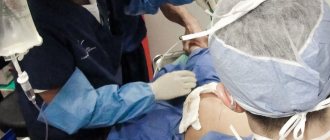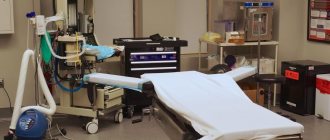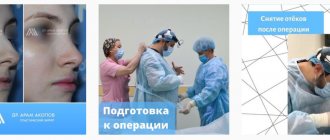Breast surgery. Preparation for surgery:
Preparation and planning for plastic surgery are very important because...
how they pursue the goal of not only the absence of complications, but also the woman’s satisfaction with the result of the operation. Therefore, at a preliminary consultation, the plastic surgeon will definitely listen to the woman’s wishes, conduct an examination, and identify possible contraindications. After the examination, our doctor will tell the woman in detail what techniques are possible to give the breasts an aesthetic appearance. Any surgical intervention is associated with a certain risk of complications. Their risk can be significantly reduced by carefully following the doctor's recommendations in the pre- and postoperative period. However, some of the possible complications are genetic and highly individual. Therefore, a qualified doctor will always tell you about the possible consequences during a preliminary consultation.
Since breast surgery is performed under anesthesia, before the operation it will be necessary to undergo a preoperative examination and consultation with an anesthesiologist who will administer anesthesia. Once your surgery date has been set, your plastic surgeon will give you instructions on how to prepare for surgery, which if followed strictly will help ensure a smoother postoperative course.
At the University Breast Center we perform the following plastic surgeries:
- Breast augmentation with implants (breast augmentation);
- Breast lift (mastopexy);
- Breast reduction (mammary reduction, breast reduction)
- Breast surgery for gender reassignment (breast removal or reconstruction);
- Liposuction and lipofilling;
- Plastic surgeries to combat aesthetic defects: Removal of additional lobules of the breast and additional mammary glands;
- Nipple and areola correction;
- Correction of breast asymmetry.
Breast augmentation should be a measured and deliberate step in your life. However, if you have already made up your mind, do not rush to run to the first clinic you come across. Look for reviews of plastic surgeons and give preference to a time-tested clinic that values its reputation. In such an institution, the doctor will definitely conduct the necessary examination of the mammary glands before the operation so as not to miss the disease. If necessary, he will be able to offer you a treatment option along with aesthetic surgery.
Postoperative period:
Plastic surgery on the mammary glands imposes some restrictions in the postoperative period. After the operation, the woman will need to wear special compression underwear (bra) for 15-30 days, which it is advisable to purchase in advance. It is not recommended to use bras with a wire frame. You must avoid physical activity for 15 days. 10-15 days after breast surgery, the swelling decreases and completely subsides, pain during movement disappears. Typically, absorbable sutures are placed during surgery and do not need to be removed. Sometimes they are supplemented with adapting sutures, which are removed 2-5 days after surgery. You will be able to evaluate the final result of mammoplasty in six months.
Contact a plastic surgeon if:
- Your breasts seem too small or too large;
- The breasts do not look as young as before: after childbirth and breastfeeding, the mammary gland has become smaller, saggy and “falls” down after removing the bra;
- The breasts have become asymmetrical: the mammary glands are of different sizes and shapes;
- You have extra lobules of mammary glands or extra mammary glands that are unsightly or cause you discomfort;
- A papilloma has appeared on the nipple or breast, the areola has enlarged and become deformed;
- You need breast plastic surgery due to gender reassignment;
- It is necessary to reconstruct the breast, nipple and areola after removal surgery.
Plastic surgery will help you cope with these problems!
Consequences and complications after breast surgery:
Among the complications of the early postoperative period are hematomas, the risk of which increases in smokers. In most cases, the blood accumulating in the cavity is completely removed through drainage.
When microbial contamination of the wound occurs, swelling and pain occur in the mammary gland area, and body temperature rises. When an infection occurs, antibiotic therapy is administered.
Excess scars can develop at the incision (access) site when a woman has a genetic predisposition. For their timely prevention, it is recommended to rub in anti-scarring medications that your doctor will prescribe. In the future, surgical correction of excess scars is possible. Impaired sensitivity, necrosis of the nipple-areolar complex and isolated skin-fat flaps can occur due to careless handling of tissues, their compression, excessive tension, and improper allocation of flaps. Necrosis requires corrective surgery.
The surgeon will tell you about the technique of other operations on the mammary glands and nipple-areolar complex, if necessary, during the consultation.
Diagnosis before breast surgery includes:
- Before 30 years - ultrasound of the mammary glands, after 30 years - MRI (a more informative method) or mammography;
- Blood tests and urinalysis;
- Electrocardiogram (ECG);
- Fluorography of the lungs;
- Ultrasound of the abdominal organs.
At the University Breast Center, our doctors will provide you with a detailed consultation, tell you about all the possible ways to solve your problem, and individually select the plastic surgery you need (or a combination of both).
Make an appointment with a doctor using the form on the website or by phone
Breast reduction
Reduction mammoplasty is an operation that surgically reduces the size and improves the contours of disproportionately large mammary glands.
If small breasts, as a rule, are an aesthetic problem, then excessive forms also cause their owners a number of practical inconveniences, ranging from difficulties in choosing clothes to limiting physical activity. Women with very large breasts also experience various medical problems: neuralgic pain in the back and neck, skin irritation, skeletal deformities and breathing problems. In such cases, reduction mammoplasty becomes the only reasonable solution. After surgery, the breasts become smaller, lighter and denser. If there are no contraindications for health reasons, the operation can be performed on adult women at almost any age. More often, the need for surgery arises after physiological and hormonal changes caused by the birth of a child; large breasts are often found in overweight women. According to statistics, every 10th representative of the fair sex needs breast reduction. And therefore, in some cases, the operation is performed for medical reasons.
Promotions and discounts
If large breasts become a big problem, it makes sense to schedule a consultation with a plastic surgeon. During a personal meeting, you can discuss the feasibility of performing reduction mammoplasty , and if the operation is necessary, determine the methodology for its implementation. During reduction, the lateral and/or lower parts of the breast are usually removed. The main task of the surgeon is to choose an option for breast reduction that will preserve the sensitivity of the nipple and areola and will not disrupt the blood supply to the mammary gland.
Contraindications for surgery:
- ARVI
- Exacerbations of chronic somatic diseases
- Blood coagulation disorders
- Diabetes
- Endocrine diseases
- Oncological diseases
Preparation for surgery includes a standard set of general clinical laboratory tests, examination by a mammologist, ultrasound of the mammary glands or mammography as indicated.
There are various techniques designed to maintain nutrition of the mammary gland and avoid disruption of blood supply. More than four dozen surgical techniques have been described. The vast majority of these are techniques with T-inverted or anchor access. T-shaped scars do not always behave correctly and often require corrective operations in the future.
Recently, the spread of the technique of reduction mammoplasty with a short scar has attracted active interest among women. The interest in this type of operation is understandable. Operations with a short scar may differ in the type of formation of the feeding pedicle, but they are united by the fact that as a result, postoperative scars remain: around the areola - circular and in the area of the lower pole - vertical, as after vertical mammoplasty.
During the operation, the “excess” breast tissue is removed, excess skin is removed, and the nipple-areolar complex is moved to the “correct” position.
Reduction mammoplasty is performed under general anesthesia; the operation lasts from 2 to 3.5 hours. I practice the incision method with a vertical scar.
With this breast reduction technique, the stitches are placed around the areola and vertically down to the fold under the breast. This technique allows you to obtain, if necessary, a significant reduction in breast volume and good shape, as well as subtle scars. During reduction mammoplasty, you can remove from 200 to 1000 grams of tissue from each breast and reduce the breast size by 3-4 or even 5 sizes. Hospitalization after such an operation is 1 day. The next day, the dressing is performed, and the patients are discharged for outpatient follow-up care. Subsequently, another 3-4 dressings are required. You can shower 5-6 days after surgery. Reduction mammoplasty, as a rule, is well tolerated by patients, there is practically no pain, and work can begin on the 5-7th day. The result of reduction mammoplasty depends on the qualifications of the surgeon. It is not for nothing that breast reduction surgery is considered one of the most difficult, and much depends on strict adherence to the doctor’s recommendations in the postoperative period. Compliance with the doctor’s requirements will allow you to avoid complications and return to your normal lifestyle within a couple of months.
After reduction mammoplasty, the breasts take shape in 3-4 months. The final result can be assessed after 6-8 months. Occasionally, after surgery, nipple asymmetry or a difference in the volume of the glands is possible. It is extremely rare for patients to be bothered by dense scars in the area of the submammary fold (under the breast). In the vast majority of cases, these problems go away on their own, after 4-6 months, but in some cases correction is required, which can even be performed on an outpatient basis, under local anesthesia, 6 months after surgery.
Mammoplasty cost in St. Petersburg
| Breast augmentation (without cost of implants): | |
| Access via the inframammary fold | from 60,000 rubles |
| Access along the lower edge of the areola (transareolar) | from 70,000 rubles |
| Access through the armpit (transaxillary) | from 90,000 rubles |
| Lifting (mastopexy) and breast augmentation: | |
| 1 category of difficulty | from 80,000 rubles |
| 2nd category of difficulty | from 95,000 rubles |
| Breast lift (mastopexy, without implants): | |
| Reducing the size of the areola | from 35,000 rubles |
| Periareolar mastopexy | from 45,000 rubles |
| Vertical mastopexy | from 75,000 rubles |
| Reduction mammoplasty: | |
| 1 category of difficulty | from 90,000 rubles |
| 2nd category of difficulty | from 120,000 rubles |
| Correction of nipple and areola size (1 side) | from 20,000 rubles |
| Correction of nipple and areola size (2 sides) | from 30,000 rubles |
| Nipple size reduction (1 side) | from 15,000 rubles |
| Lipofilling of the mammary glands | from 60,000 rubles |
| Correction of inverted nipple (1 side) | from 15,000 rubles |
| Correction of inverted nipple (2 sides) | from 30,000 rubles |
| Reconstructive operations on the mammary glands: | |
| Breast reconstruction using an expander | from 30,000 rubles |
| Breast reconstruction using free or transferred flaps | from 60,000 rubles |
| Restoration of mammary glands using a combined method | from 80,000 rubles |
Photo gallery of breast augmentation results










